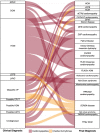The role of genetic testing in diagnosis and care of inherited cardiac conditions in a specialised multidisciplinary clinic
- PMID: 36578016
- PMCID: PMC9795753
- DOI: 10.1186/s13073-022-01149-0
The role of genetic testing in diagnosis and care of inherited cardiac conditions in a specialised multidisciplinary clinic
Abstract
Background: The diagnostic yield of genetic testing for inherited cardiac diseases is up to 40% and is primarily indicated for screening of at-risk relatives. Here, we evaluate the role of genomics in diagnosis and management among consecutive individuals attending a specialised clinic and identify those with the highest likelihood of having a monogenic disease.
Methods: A retrospective audit of 1697 consecutive, unrelated probands referred to a specialised, multidisciplinary clinic between 2002 and 2020 was performed. A concordant clinical and genetic diagnosis was considered solved. Cases were classified as likely monogenic based on a score comprising a positive family history, young age at onset, and severe phenotype, whereas low-scoring cases were considered to have a likely complex aetiology. The impact of a genetic diagnosis was evaluated.
Results: A total of 888 probands fulfilled the inclusion criteria, and genetic testing identified likely pathogenic or pathogenic (LP/P) variants in 330 individuals (37%) and suspicious variants of uncertain significance (VUS) in 73 (8%). Research-focused efforts identified 46 (5%) variants, missed by conventional genetic testing. Where a variant was identified, this changed or clarified the final diagnosis in a clinically useful way for 51 (13%). The yield of suspicious VUS across ancestry groups ranged from 15 to 20%, compared to only 10% among Europeans. Even when the clinical diagnosis was uncertain, those with the most monogenic disease features had the greatest diagnostic yield from genetic testing.
Conclusions: Research-focused efforts can increase the diagnostic yield by up to 5%. Where a variant is identified, this will have clinical utility beyond family screening in 13%. We demonstrate the value of genomics in reaching an overall diagnosis and highlight inequities based on ancestry. Acknowledging our incomplete understanding of disease phenotypes, we propose a framework for prioritising likely monogenic cases to solve their underlying cause of disease.
Keywords: Genetic testing; Inherited cardiac conditions; Sudden cardiac death.
© 2022. The Author(s).
Conflict of interest statement
J. Ingles receives research grant support from Bristol Myers Squibb. The remaining authors declare that they have no competing interests.
Figures





References
-
- Ackerman MJ, Priori SG, Willems S, et al. HRS/EHRA expert consensus statement on the state of genetic testing for the channelopathies and cardiomyopathies this document was developed as a partnership between the Heart Rhythm Society (HRS) and the European Heart Rhythm Association (EHRA) Heart Rhythm. 2011;8:1308–1339. doi: 10.1016/j.hrthm.2011.05.020. - DOI - PubMed
-
- Hershberger RE, Givertz M, Ho CY, et al. Genetic evaluation of cardiomyopathy - a Heart Failure Society of America practice guideline. J Card Fail. 2018.
Publication types
MeSH terms
LinkOut - more resources
Full Text Sources
Medical

